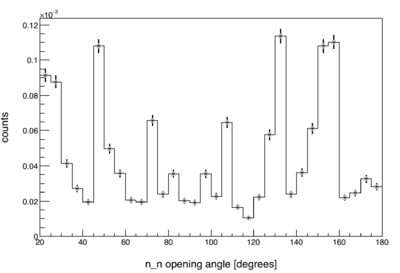Difference between revisions of "2NCorr SPDP Introduction"
| Line 4: | Line 4: | ||
<div><ul> | <div><ul> | ||
| − | <li style="display: inline-block;"> [[File:2N Corr OpeningAngleCf252.png|thumb|400px| Measured opening angle distribution of | + | <li style="display: inline-block;"> [[File:2N Corr OpeningAngleCf252.png|thumb|400px| Measured opening angle distribution of neutrons from the spontaneous fission of Cf252.]]</li> |
For this reason, every measured distribution is made meaningful by normalizing against a "control" distribution. This is done by diving the values of the measured distribution by the control distribution on a bin-by-bin basis. For <math>\theta_{nn}</math>, the control distribution is made by looking at pairs of two separate pulses, and if there is a neutron event in both pulses, the opening angle between the two events is calculated. Since no information can be shared between the neutrons of different pulses, the control distribution is completely free of correlations, but is nonetheless subject to the usual effects of detector geometry and efficiency as a function of position and energy. So what is meant by "angular correlation" here, is the measured rate relative to a totally uncorrelated neutron source. | For this reason, every measured distribution is made meaningful by normalizing against a "control" distribution. This is done by diving the values of the measured distribution by the control distribution on a bin-by-bin basis. For <math>\theta_{nn}</math>, the control distribution is made by looking at pairs of two separate pulses, and if there is a neutron event in both pulses, the opening angle between the two events is calculated. Since no information can be shared between the neutrons of different pulses, the control distribution is completely free of correlations, but is nonetheless subject to the usual effects of detector geometry and efficiency as a function of position and energy. So what is meant by "angular correlation" here, is the measured rate relative to a totally uncorrelated neutron source. | ||
Revision as of 22:35, 19 January 2018
Our array of detectors has a highly non-uniform neutron efficiency and acceptance w.r.t. neutron-neutron opening angle (). This is due to the array's non-spherically symmetric geometry, and to its neutron detection efficiency as a function of both particle position and energy (see figure).
For this reason, every measured distribution is made meaningful by normalizing against a "control" distribution. This is done by diving the values of the measured distribution by the control distribution on a bin-by-bin basis. For , the control distribution is made by looking at pairs of two separate pulses, and if there is a neutron event in both pulses, the opening angle between the two events is calculated. Since no information can be shared between the neutrons of different pulses, the control distribution is completely free of correlations, but is nonetheless subject to the usual effects of detector geometry and efficiency as a function of position and energy. So what is meant by "angular correlation" here, is the measured rate relative to a totally uncorrelated neutron source.
